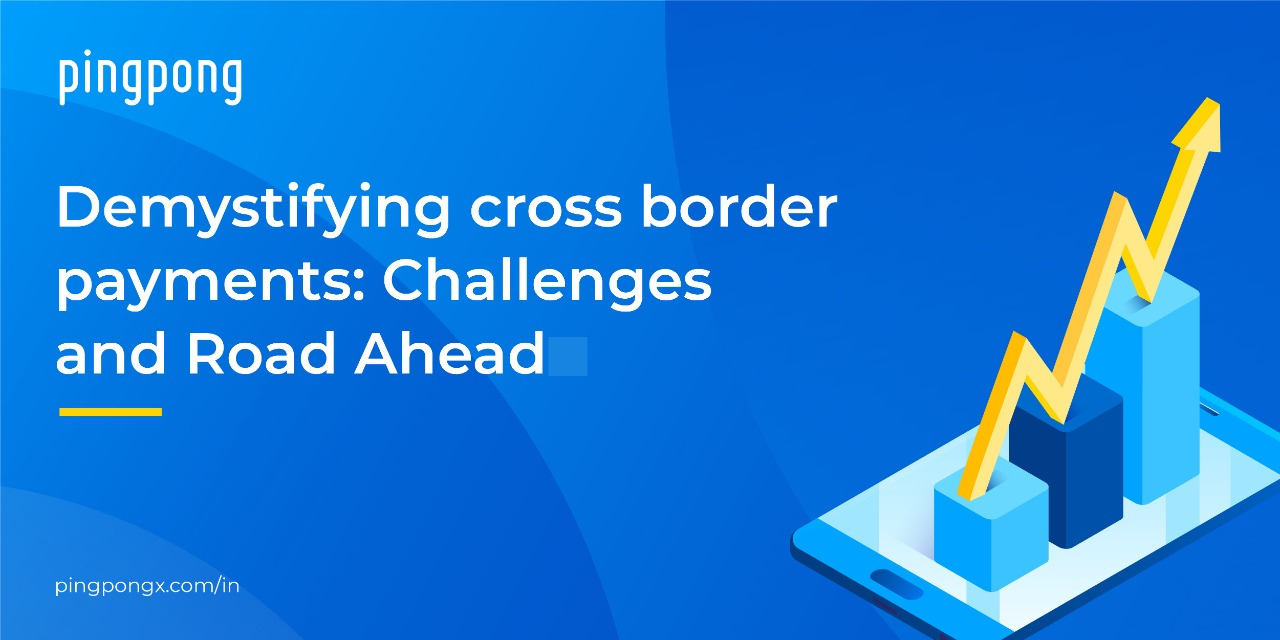
Introduction:
Where there is a will, there's away!
No, there is nothing to decode in this. You reading this already know that humans are capable of doing everything they want.
The world has evolved over technology. Ever since some intelligent minds explored the depth of science behind expanding business, cross-border payments started. That was the victory mark when merchants, freelancers, and agents took their businesses abroad and made profits. Cross border payments broadly involve funds transfer in which the sender and the recipient belong to different jurisdictions.
This type of outside Indian boundary payment includes retail, corporate, and entrepreneurial transactions. Over a period of time, the share of digital transactions in India has increased considerably from 2014 to 2019. In 2019, the percentage share of digital payments accounted for 769 percent of India's GDP. This increase in the amount was due to digitization and cross-border payment service enhancement.
Let us understand how cross-border payment evolved.
Table of Contents
- How did cross border payments start in India?
- The emergence of the correspondent banking system in the cross border payment system.
- What is a payment processor?
- Challenges in cross-border payments.
- Future of cross border payment systems.
- Conclusion
How did cross border payments start in India?
Do you remember the time when people booked trunk calls to connect with their relatives over the phone? Soon the landline came and now every pocket has a mobile phone.
This is called the progressive approach to cope with the changing lifestyles!
Agreed or not, with facilities, people meet their desires as they look for continuous growth.
Similar is the case with the cross-border payment system in India. In the traditional ways of cross-border payments, initially, people carried hard cash across countries, sent money through couriers, or used acquaintances. They also used a hawala- broker network to transfer the funds for business payments. But considering the security over the physical money transfer, people in India preferred online cross-border payments.
In the last few years, the percentage of digital payments has increased to significantly contribute to the GDP.
Digital Transaction as a share of GDP
Digital payments whether domestic or international is the fact of life. To boost digital payments, the Ministry of Electronics and Information Technology has introduced measures to push digital payments. For example, they introduced correspondent banking, BHIM cashback schemes, and UPI payment systems.
The emergence of correspondent banking in the cross-border payment system.
It started with the opening up of communication networks.
Role of communication network:
In the early 1930s,the Telex-a network of teleprinters was created, which connected the banks with their overseas counterparts. For a long time, banks used this tool to facilitate international payments.
Later, in 1973 nearly 239 banks from about 15 countries joined to make a standardized communication system. It was called SWIFT- the Society for Worldwide Interbank Financial Telecommunication. It was a standard model for all the banks to attain a smooth relationship over the cross-border transactions. The idea was to set a model for communication for international payments.
Soon it was realized that this was not the only requisite to attain a smooth level of transaction flow. Hence, the banks developed new financial institutions called correspondent banking.
Under the correspondent banking system, Bank A in one country can transfer the funds to Bank B in another country only digitally. Each needs to have an account in the other bank. During the process. there is no physical movement of the currencies. Instead, there is a credit in one zone and a debit in the other.
This became a restricted activity where the banks agreed to follow the SWIFT regulations. Later one issue came to light when the banks wanted to transfer money across countries abroad. International payments could be made possible only when the banks had multiple branches in each country. Only the banks with massive infrastructure could have established connections with the bank intermediaries (correspondent banks) for money transfer.
This combination of SWIFT and correspondent banking could make money moving possible for 40 years.
Inhibitions in the cross border payment were further removed with the emergence of payment processors.
Role of payment processors in cross-border payments
India is estimated to contribute 2.2 percent of the world's digital payments market by 2023. These transactions are expected to touch a mark of $12.4 trillion by 2025.
The online purchase market is booming to the core, but merchants find it challenging to handle everything independently. This is where payment processors came into being. Merchants and others rely on payment service providers and payment gateways to make card transactions easy.
Merchants and business owners choose digital transactions as it involves a seamless process in which everything transpires in the blink of an eye. But there is a lot that goes behind the scenes. It is the payment processor that handles everything at the backend.
For now, let us look in detail at the role of a payment processor.
What is a payment processor?
A payment processor is an intermediary between the bank and the merchant. For example, when the customer makes a purchase, the payment service provider receives the information from the merchant. Further, the processor relays the information to the bank.
For any discrepancies noted during the payment, the service provider will intimate the merchant. Once everything is clear, the payment is forwarded to the merchant's bank account. For every transaction that takes place, the payment processor will charge a transaction fee.
In India, the fast-paced digital payments can be attributed to government-backed incentives and regulations of costs of payment systems. Payment processors have supported cross-border transactions making it convenient for merchants and freelancers to expand their business.
Even though the payment solution providers have eased the entire process, there still exist some challenges in the cross border payments.
Challenges in cross-border payments
Receiving international payments at times involves some challenges. Despite being connected to the banks and correspondent banking, the transactions at times become slow. Addressing the challenges is a must because it can lead to dissatisfied customers that further damage your business.
Let us look at the significant challenges of cross border payments.
- Slow payment processing.
When the payments are suddenly stopped due to internet connectivity or technical connectivity issues, the payment processing goes slow. This slow processing can lead to delayed or dissatisfied customers. In addition, a delay in payment can happen in reconciling the payment information.
At times, the users can feed in incorrect information or AML checks and frauds. In addition, a lack of standard compiling procedures about the information can reduce the speed of payment processing.
2. Data privacy regulations.
The cross border payment process can get complex if the users do not read the payment instructions. All the merchant, bank, payment processor, and the customer needs to read the regulations closely.
Before using the payment processor, do not read about the General Data Protection Regulations (GDPR). There should be strict regulation on sharing the clients' data as that affects the client's trust.
3. Out-of-date operating systems.
The cross border payments are supported with a messaging network that includes SWIFT M103. It is highly reliable, but the amount of information it can carry is limited. For anything higher than MT103, the data is transmitted through MT199. Beyond this, the messages are sent through emails.
Operational inefficiencies in messaging can cause delay or dissatisfaction in payment processing.
Despite the challenges, it is a fact that the number of cross-border payments has increased. Moreover, it will continue in the near future as there is a surge in online businesses and freelancers.
Future of cross-border payment systems- Road Ahead
Cross border payments have evolved to support the fast-growing number of digital payment users. Digital payment methods are a cost-effective and fast way to transfer money online, even at an international level.
Apart from the common scenario, online payment has shown a steep rise after the Covid-19 pandemic. People who can work remotely have continued to do so because receiving payment is not a problem anymore.
Factors that have contributed to the growth of cross-border payments include expanding supply chains, eCommerce, global investment flows, and international trade. Keeping in mind the best possibilities, let us look at the future of cross border payment systems.
- Technological shift with Payment Service Providers:
The PSPs will continue to explore ways to satisfy the demand of the customers. As an alternative, cross-border payments, cryptocurrencies, and blockchains are already fetching attention. Blockchain technology brought down the cost of international transactions by reducing the number of intermediaries. Unlike Bitcoin, Stablecoin is winning attention as it is more stable by pegging its value to external references. Payment Service providers like PingPong are capturing the attention of users because of its secure, safe, and low-cost payment services.
- Standardized needs of transparency:
Improvements will be made in the cross-border payments bringing in more transparency and benefits for the customers.
- Better collaboration between fintech and banks:
The future demands more banks and payment solution providers to step in. It will help to create solutions to offer a hassle-free experience to the customers. Fintechs must initiate to make their product and services perfect. Banks, on the other hand, can concentrate on revamping their old-fashioned systems. Together their collaboration will create an impression on customers that leads to prestigious relationships.
- Innovating issuers:
As more and more users become confident in cross-border digital payments, they have become less tolerant of lousy check-out experiences. They want authentic and fraud-free payment solution providers. Customers look for international payment solutions in multiple currencies. Savvy merchants must choose payment processors that streamline the payment journey.
- Biometrics Authentication:
With the rise in online transactions, the number of frauds have also increased. Keeping in mind the scenario, the payment processors and banks should better protect their customers' information. To prevent fraud, businesses should use biometrics, especially those who deal in Europe and the USA markets. Biometrics will help to authenticate payments, never leaving room for default or fraudulent charges.
Conclusion:
The enlargement of cross-border payment is expected when you consider technology and demands both fall into place. In the changing scenario, the cash displacement has moved the way up for cross-border payments. With online payment solutions, numerous costs are associated with the banking transaction fees. Therefore, you must look for alternatives of payment processors that offer transaction facilities at a low price. It will save you more money leading to profit generation.

